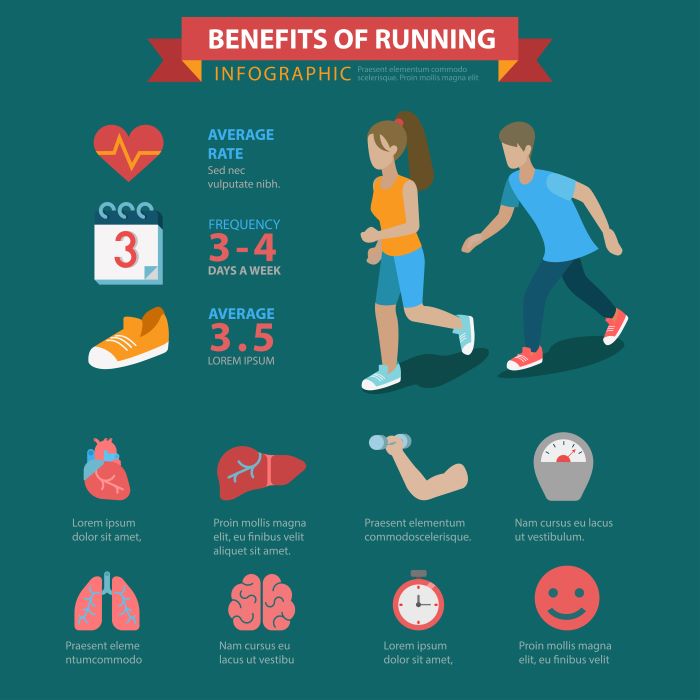Running is not just a simple act of putting one foot in front of the other; it is a complex workout that engages various muscle groups throughout the body. When you lace up your shoes and hit the pavement, you are primarily targeting your lower body muscles, including:
- Quadriceps: Located at the front of your thighs, these muscles are crucial for extending your knees and propelling you forward.
- Hamstrings: Found at the back of your thighs, hamstrings work to flex your knees and stabilize your running posture.
- Calves: Comprising the gastrocnemius and soleus muscles, your calves play a vital role in pushing off during each stride.
- Glutes: The gluteus maximus, medius, and minimus help in hip extension and stabilization, contributing to a powerful running form.
However, running is not limited to just the legs. Your core muscles also benefit significantly from this activity. A strong core enhances your stability and posture, reducing the risk of injury. Muscles such as the abdominals and obliques help maintain balance and power during your runs.
Moreover, your upper body plays a role as well. While it might not seem obvious, your arms contribute to your running rhythm, providing momentum with each swing. Engaging your shoulders and back can improve your overall efficiency.
If you’re eager to explore how to optimize your running routine for better results, visit our website to learn more and get started today! Click here.
How Running Impacts Cardiovascular Health and Stamina

Engaging in regular running has profound effects on cardiovascular health and overall stamina. When you run, your heart rate increases, promoting better blood circulation throughout your body. This not only strengthens the heart muscle but also enhances its efficiency in pumping blood, which is crucial for delivering oxygen and nutrients to your muscles.
Here are some key ways running impacts your cardiovascular system:
- Improved Heart Function: Consistent running can lower resting heart rates and blood pressure, leading to a healthier heart.
- Decreased Risk of Heart Disease: Studies show that regular runners have a significantly lower risk of developing cardiovascular diseases compared to sedentary individuals.
- Enhanced Lung Capacity: Running encourages deeper inhalation and improves lung function, which increases the oxygen supply to your body.
- Better Cholesterol Levels: Running helps raise good cholesterol (HDL) while lowering bad cholesterol (LDL), contributing to a healthier lipid profile.
Aside from cardiovascular benefits, running also plays a vital role in boosting stamina. As you challenge your body through distance or speed, you gradually build endurance. This not only allows you to run longer distances but also helps you perform daily activities with greater ease.
Furthermore, the mental health benefits of running, including stress reduction and improved mood, contribute to a more active lifestyle, encouraging consistency in your workouts. Ultimately, the combination of physical and mental benefits from running paves the way for a healthier, more fulfilling life.
Exploring Different Running Environments and Their Benefits

Exploring various running environments can significantly enhance your fitness routine, making every run a unique experience. From urban landscapes to serene trails, each setting offers its own distinct benefits that can impact your workout and overall enjoyment.
Here’s a look at some popular running environments and what they offer:
- Urban Routes: Running in city settings provides a dynamic atmosphere. The varied terrain, including hills and flat surfaces, challenges different muscle groups. Additionally, the hustle and bustle of city life can be motivating, especially in scenic parks or along waterfronts.
- Trail Running: Trails allow you to connect with nature while providing a softer surface that can reduce impact on your joints. The natural elevation changes improve strength and stability, while the peaceful surroundings can enhance mental well-being and reduce stress.
- Track Running: Tracks offer a controlled environment ideal for speed work and interval training. The measured distances make it easier to track progress and set goals, which can be incredibly motivating for runners of all levels.
- Beach Running: Running on sand provides a unique challenge that engages your core and stabilizing muscles. The resistance of the sand can increase the intensity of your workout, while the calm sound of waves can create a relaxing atmosphere.
Experimenting with different environments not only keeps your running routine fresh but also allows you to reap various physical and mental benefits. By diversifying your running locations, you can discover new routes, meet fellow runners, and build a sense of community, making each step more enjoyable.
The Role of Running in Weight Management and Fat Loss

Running plays a crucial role in weight management and fat loss, serving as an effective tool for burning calories and improving overall fitness. As a high-intensity cardiovascular exercise, it elevates your heart rate, leading to increased energy expenditure both during and after your workouts.
Here are some key aspects of how running contributes to weight management:
- Calorie Burn: Running is one of the most efficient ways to burn calories. On average, a person can burn between 400 to 800 calories per hour depending on their weight, pace, and running terrain. Incorporating regular runs into your routine can create a calorie deficit, essential for weight loss.
- Metabolism Boost: Engaging in running not only burns calories during the activity but also boosts your metabolism for hours afterward, a phenomenon known as excess post-exercise oxygen consumption (EPOC). This means you continue to burn more calories even when you’re at rest.
- Fat Utilization: As you build endurance through running, your body becomes more efficient at utilizing fat as a fuel source. This adaptation is particularly beneficial for long-term weight management, helping you sustain energy levels while reducing fat stores.
- Mood Enhancement: Running has psychological benefits that can aid in weight management. The release of endorphins during a run can improve mood and reduce stress, which is often linked to emotional eating. By enhancing your mental health, running can help you make better food choices.
Incorporating running into a balanced fitness plan not only aids in weight loss but also promotes a healthier lifestyle. By combining running with a nutritious diet, you can achieve and maintain your weight loss goals effectively.
Injury Prevention Strategies for Every Running Enthusiast

Running is a fantastic way to enhance fitness, but it also comes with the risk of injuries if not approached with care. To keep you on the trails and roads, implementing effective injury prevention strategies is essential for every running enthusiast.
Here are several strategies to help minimize the risk of injury:
- Proper Footwear: Choosing the right running shoes is fundamental. Ensure your shoes are suited to your foot type, running style, and the terrain you frequent. A well-fitting pair not only provides support but also absorbs impact, reducing stress on your joints.
- Warm-Up and Cool Down: Always start your runs with a warm-up to prepare your muscles and joints for the workout ahead. Dynamic stretches can enhance flexibility and reduce stiffness. After running, take time to cool down and perform static stretches to prevent muscle tightness.
- Listen to Your Body: Pay attention to any signs of discomfort or pain. Early intervention can prevent more severe injuries. If you experience persistent pain, consider consulting a healthcare professional or a physical therapist to address the issue.
- Gradual Progression: Avoid the temptation to increase your mileage or intensity too quickly. Follow the 10% rule: increase your weekly mileage by no more than 10% to reduce the risk of overuse injuries.
- Cross-Training: Incorporating other forms of exercise, such as swimming, cycling, or strength training, can enhance overall fitness while giving your running muscles a break. This variety helps improve your strength and flexibility without overloading specific muscle groups.
By adopting these injury prevention strategies, you can enjoy running while minimizing your risk of setbacks. Remember, a proactive approach to your running routine fosters not only longevity in the sport but also a more enjoyable experience.
Joining a Community to Enhance Your Running Journey
Engaging with a community of fellow runners can significantly enhance your running journey. Being part of a supportive group fosters motivation, accountability, and camaraderie, which can elevate your experience and performance.
Here are some compelling reasons to consider joining a running community:
- Shared Goals: Surrounding yourself with like-minded individuals who share similar fitness goals can help maintain your motivation. Group runs and events encourage you to push your limits while providing a sense of belonging.
- Knowledge Exchange: Being part of a community offers access to a wealth of knowledge. Experienced runners can share tips on training techniques, injury prevention, and nutrition, helping you to improve your running skills.
- Accountability: Having a network of friends who expect you at group runs or events can keep you committed to your training schedule. This accountability can help you stay on track, especially during days when your motivation wanes.
- Social Connections: Running communities often create lasting friendships. Participating in group activities, whether it’s a local race or a casual meetup, can turn casual acquaintances into lifelong friends.
- Variety and Fun: Joining a community can introduce you to new running routes, events, and challenges. The diversity in training sessions and social activities keeps your running routine fresh and enjoyable.
Whether you join a local running club, participate in online forums, or engage with a social media group, being part of a running community can enrich your journey. Visit our website to learn more and get started today! Click here.


